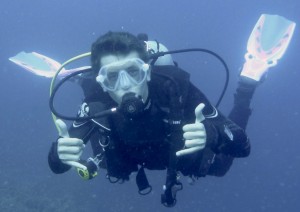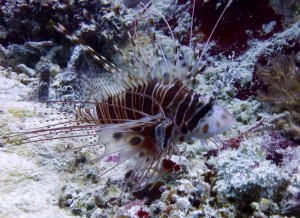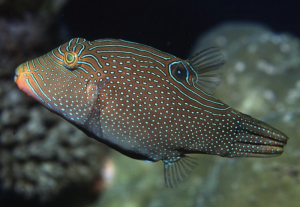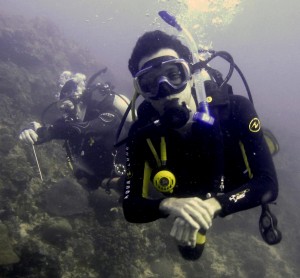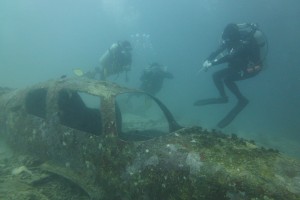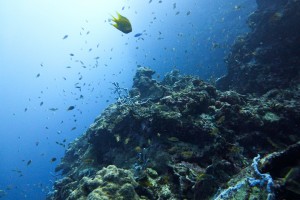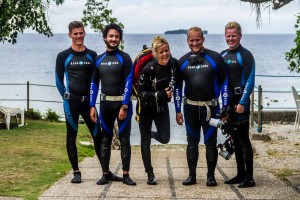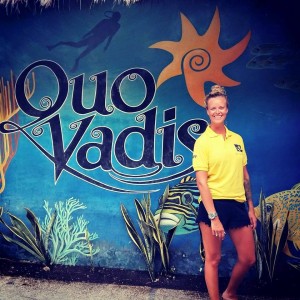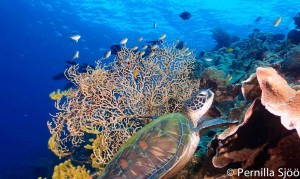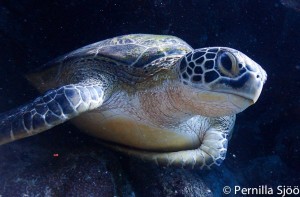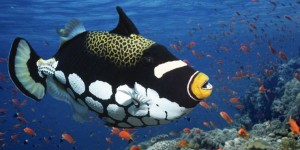Equipment Recommendations
Selecting your first set of SCUBA equipment can be an overwhelming prospect. There are so many kinds and variations, colors, brands and functionality to consider; too many in fact to 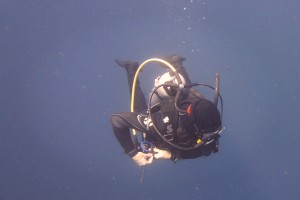 discuss at depth in this segment however we may attempt to tackle this in the future. For now we want to delve into the specialized equipment, beyond your standard kit, that we recommend when diving with just you and a buddy. Like selecting your basic gear there are so many tools, gadgets, attachments and toys to salivate over and attempt to convince yourself are absolutely necessary; however we recommend beginning with the basics and consider if the item’s weight, bulk and size justify a spot in or on our BCD. As a baseline we would recommend at minimum a cutting tool, torch, visual signal, audible signal, first aid and emergency oxygen.
discuss at depth in this segment however we may attempt to tackle this in the future. For now we want to delve into the specialized equipment, beyond your standard kit, that we recommend when diving with just you and a buddy. Like selecting your basic gear there are so many tools, gadgets, attachments and toys to salivate over and attempt to convince yourself are absolutely necessary; however we recommend beginning with the basics and consider if the item’s weight, bulk and size justify a spot in or on our BCD. As a baseline we would recommend at minimum a cutting tool, torch, visual signal, audible signal, first aid and emergency oxygen.
Cutting Tools
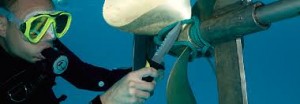 A cutting tool is a recommended for all divers for both safety and utilitarian purposes. It is not recommended as a weapon for defense against “aggressive” underwater creatures; not only is this impractical but also goes directly against the sustainable underwater stewardship that we have committed to as divers. Cutting tools come with a few basic options, fixed blade vs. collapsible, blunted tip vs. pointed and steel vs. titanium. While there are valid arguments for both sides of the fixed vs. collapsible and blunted vs. pointed tips I would recommend that you take your BCD, exposure suits and diving conditions into consideration when making these decisions. When considering steel vs. titanium there are very clear benefits and costs associated. If you are working with a tight budget then a stainless steel blade will definitely be more affordable; however please investigate the grade of the stainless as there are some lower grades that will rust almost instantly when introduced to salt water whereas there are some that with a gentle rinse or short soak after a dive in fresh water will remain rust free for years. If you budget allows it a titanium blade is a well-placed investment as in addition to being lighter it should also remain rust free, even if you forget to rinse or soak it, for many years to come. Two features that I personally recommend are a line cutter separate from the cutting edge and a lanyard to avoid an unfortunate loss under the water.
A cutting tool is a recommended for all divers for both safety and utilitarian purposes. It is not recommended as a weapon for defense against “aggressive” underwater creatures; not only is this impractical but also goes directly against the sustainable underwater stewardship that we have committed to as divers. Cutting tools come with a few basic options, fixed blade vs. collapsible, blunted tip vs. pointed and steel vs. titanium. While there are valid arguments for both sides of the fixed vs. collapsible and blunted vs. pointed tips I would recommend that you take your BCD, exposure suits and diving conditions into consideration when making these decisions. When considering steel vs. titanium there are very clear benefits and costs associated. If you are working with a tight budget then a stainless steel blade will definitely be more affordable; however please investigate the grade of the stainless as there are some lower grades that will rust almost instantly when introduced to salt water whereas there are some that with a gentle rinse or short soak after a dive in fresh water will remain rust free for years. If you budget allows it a titanium blade is a well-placed investment as in addition to being lighter it should also remain rust free, even if you forget to rinse or soak it, for many years to come. Two features that I personally recommend are a line cutter separate from the cutting edge and a lanyard to avoid an unfortunate loss under the water.
Torches
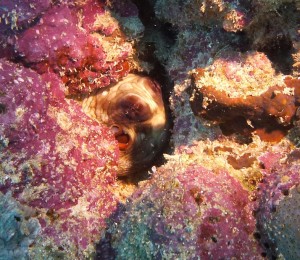
Illuminating an Octopus hiding in the cracks with a 700 lumen torch at around 12 meters; without it would be nearly impossible to make it out.
There are enough torch options out there to make a thorough exploration impractical; however there are a few key features that can be taken into consideration. A good starting point can be investigating the lumens of the torch and taking into consideration what conditions you will be using this in. I have witnessed divers using 10,000 lumen video lights on a night dive before; effectively turning it into a day dive for everyone and possibly blinding every poor creature caught in its beam…Please don’t do this! For guiding a dive or for dive professionals we recommend at minimum a 300 lumen light though 700 lumen will definitely make you visible to other divers while still keeping in the spirit of a night dive. Another feature to consider is the battery type. Some come with rechargeable batteries while other manufacturers recommend that you do not use rechargeable batteries due to corrosion concerns. While I have seen some torches with more uncommon 3v lithium batteries, like those used in older digital cameras; these can prove quite difficult and expensive to source, especially when traveling. Finally I would recommend thinking about the size, shape and method of attachments. As you begin to amass more dive equipment space and weight become a growing concern and when using a tool, like a torch, on frequent basis the comfort and ergonomics become more of a determining factor when making your selection.
Visual and Audio Signals
The general recommendation is that all divers carry at minimum one visual and one auditory signaling device; please check with you local authorities for any area specific flag and float requirements. In my experience I have had more than one occasion to need two of each; if you are diving with just you and a buddy I would recommend you do the same. I keep a smaller backup plastic SMB (Surface Maker Buoy) in the pocket of my BCD with 7 meters of line 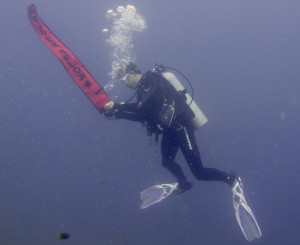 and a small fishing weight wrapped around it. The plastic won’t mold and rot as easily like the fabric SMBs making it perfect for keeping in a damp pocket. For a primary SMB there are a variety of options from colors, size, inflation type, reel length and type, etc. I would recommend that you select a set up that is appropriate for the diving you will be focusing on; such as having a 15 meter reel and smaller SMB for a shallow, calm lake or a 30 meter reel and larger SMB for choppy ocean drift diving for easier spotting from the boat.
and a small fishing weight wrapped around it. The plastic won’t mold and rot as easily like the fabric SMBs making it perfect for keeping in a damp pocket. For a primary SMB there are a variety of options from colors, size, inflation type, reel length and type, etc. I would recommend that you select a set up that is appropriate for the diving you will be focusing on; such as having a 15 meter reel and smaller SMB for a shallow, calm lake or a 30 meter reel and larger SMB for choppy ocean drift diving for easier spotting from the boat.
For the auditory devices I personally prefer whistles as there is very little that can malfunction on them. I prefer to have both a standard common whistle, such as the ones that often come with a BCD, for everyday use. I also keep a Storm whistle for emergencies; this is purported to be the loudest whistle on the market, while I doubt that, it is louder than what is pleasant but will definitely get peoples attention quickly in an emergency. Whatever you select i would ensure that they are attached securely and close enough to your mouth to have quick and efficient access. I would also ensure that they are attached with stainless fasteners to avoid rust and corrosion.
First Aid and Emergency Oxygen
I will start this section with the following disclaimer: you need to act and stay within your level of training and comfort whenever administering first aid, CPR or emergency oxygen. If you are in doubt please visit your local dive shop and inquire about the EFR, Emergency Oxygen Provider and Rescue Diver courses; these are specialized courses with a focus on responding to diving related accidents and are a prudent investment if you will be diving without professionals. You can find a general recommendation for a first aid kit in the back of the EFR manuals and may be able to get additional local recommendations 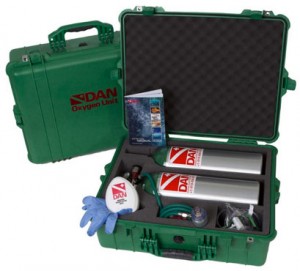 from your dive shop or other experienced divers. Emergency Oxygen kits with waterproof cases are available though many dive suppliers, dive shops and first aid suppliers. You should take into consideration the elevation and proximity of your dive site to EMS when determining the appropriate Oxygen cylinder size for your kit; you wouldn’t want to carry the kit around for years and need it only to find that you have only a 10 minute supply for a 2 hour drive. Again, if you are the least bit uncomfortable in these areas I strongly suggest you seek additional guidance or training from your local diving professionals.
from your dive shop or other experienced divers. Emergency Oxygen kits with waterproof cases are available though many dive suppliers, dive shops and first aid suppliers. You should take into consideration the elevation and proximity of your dive site to EMS when determining the appropriate Oxygen cylinder size for your kit; you wouldn’t want to carry the kit around for years and need it only to find that you have only a 10 minute supply for a 2 hour drive. Again, if you are the least bit uncomfortable in these areas I strongly suggest you seek additional guidance or training from your local diving professionals.
The Next Stride
Check in next week when we will discuss some continuing education options to hone your dive planning skills. Please feel free to send us your questions, comments or input about this series or requests for future series.
Please send comments and questions to Andy@QuoVadisResort.com
View the previous post here: I’m a certified diver: Selecting a local dive site
